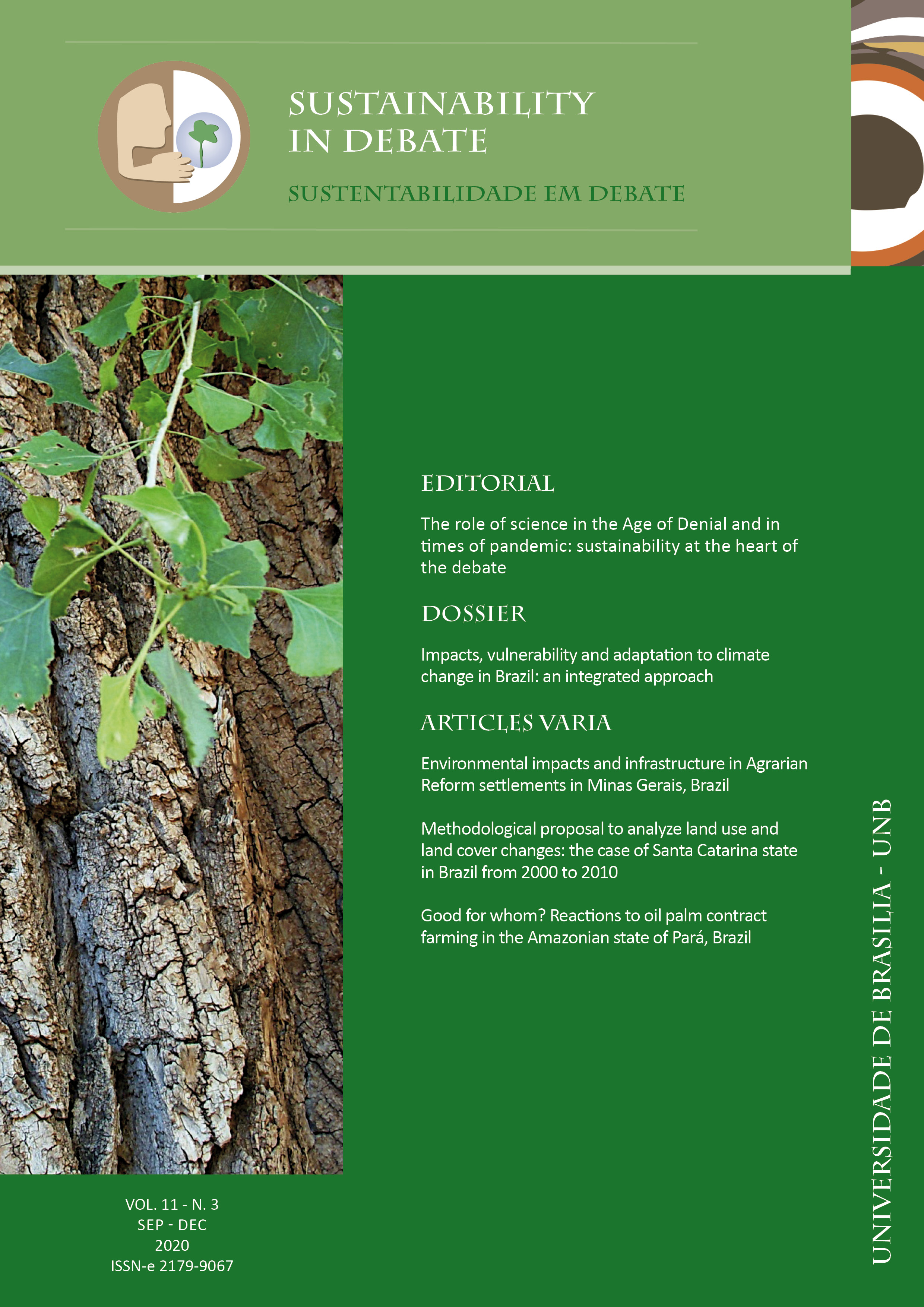Projections of Brazilian biomes resilience and socio-environmental risks to climate change
DOI:
https://doi.org/10.18472/SustDeb.v11n3.2020.33918Resumo
Climate change has been considered, at a global level, as one of the main anthropogenic drivers of environmental transformation, especially on biomes, ecosystems and the most vulnerable population. In this regard, the concept of resilience has been widely used in ecology to explain the ecosystem transition thresholds by which forests and other habitats are able to restructure in the face of various external disturbances. However, the concept of resilience in facing climate change impacts and risks through the lens of socio-environmental risks in Brazil is still underdeveloped, especially at the biome level. This article uses the theory of critical transitions to ecological niche distribution modeling in future global warming scenarios by the end of the century, in order to highlight the change in ecological resilience of the Amazon, Caatinga, Cerrado, Atlantic Forest and Pampa biomes, and how the changes in resilience can lead to an increased exposure, vulnerabilities and risks to socio-environmental security. This article shows how an interdisciplinary approach bringing together modeling of biome resilience may be a tool to support decision making and public policies on mitigation and adaptation to climate change and reduce risks to socio-environmental security.
Downloads
Referências
ALLOUCHE, O.; TSOAR, A.; KADMON, R. Assessing the accuracy of species distribution models: prevalence, kappa and the true skill statistic (TSS). Journal of Applied Ecology, v. 43, n. 6, p. 1223-1232, set. 2006.
AMBRIZZI, T. et al. Cenários regionalizados de clima no Brasil para o século XXI: projeções de clima usando três modelos regionais. Ministério do Meio Ambiente. Secretaria de Biodiversidade e Florestas. Diretoria de Conservação da Biodiversidade ”“ Mudanças climáticas globais e efeitos sobre a biodiversidade. Subprojeto: caracterização do clima atual e definição das alterações climáticas, v. 3, p. 112, 2007.
ANADÓN, J. D.; SALA, O. E.; MAESTRE, F. T. Climate change will increase savannas at the expense of forests and treeless vegetation in tropical and subtropical Americas. Journal of Ecology, 2014.
ANJOS, L. J. S.; TOLEDO, P. M. DE. Measuring resilience and assessing vulnerability of terrestrial ecosystems to climate change in South America. PLOS ONE, v. 13, n. 3, p. e0194654, 19 mar. 2018.
BETTS, R. A. et al. Changes in climate extremes, fresh water availability and vulnerability to food insecurity projected at 1.5°C and 2°C global warming with a higher-resolution global climate model. Phil. Trans. R. Soc. Lond. A, v. 376, 2018.
BRONDÃZIO, E. S. et al. Social and health dimensions of climate change in the Amazon Annals of Human Biology, 2016. Disponível em: <http://www.tandfonline.com/doi/full/10.1080/03014460.2016.1193222>
BURKE, M.; HSIANG, S. M.; MIGUEL, E. Global non-linear effect of temperature on economic production. Nature, v. 527, n. 7577, 2015.
CARLETON, T. A.; HSIANG, S. M. Social and economic impacts of climate. Science, 2016.
CHAMBERS, J. C.; ALLEN, C. R.; CUSHMAN, S. A. Operationalizing Ecological Resilience Concepts for Managing Species and Ecosystems at Risk. Frontiers in Ecology and Evolution, 2019.
CHOU, S. C. et al. Evaluation of the Eta Simulations Nested in Three Global Climate Models. American Journal of Climate Change, 2014.
COMER, P. J. et al. Habitat climate change vulnerability index applied to major vegetation types of thewestern interior United States. Land, 2019.
DINIZ FILHO, J. A. F. et al. Partitioning and mapping uncertainties in ensembles of forecasts of species turnover under climate change. Ecography, v. 32, n. 6, p. 897-906, dez. 2009.
DONOGHUE, M. J.; EDWARDS, E. J. Biome Shifts and Niche Evolution in Plants. Annual Review of Ecology, Evolution, and Systematics, v. 45, n. 1, p. 547-572, 2014.
EMBRAPA. Agricultura familiar no Brasil.
FOLKE, C. et al. Regime shifts, resilience, and biodiversity in ecosystem management. Annual Review of Ecology, Evolution, and Systematics, 2004.
GIANNINI, T. C. et al. Projected climate change threatens pollinators and crop production in Brazil. PLOS ONE, v. 12, n. 8, p. e0182274, 9 ago. 2017.
GUNDERSON, L. H. Ecological Resilience: in theory and application. Annual Review of Ecology and Systematics, v. 31, n. 1, p. 425-439, nov. 2000.
HIROTA, M. et al. Global resilience of tropical forest and savanna to critical transitions. Science, 2011.
JOLY, C. A. et al. 1° Diagnóstico Brasileiro de Biodiversidade e Serviços Ecossistêmicos. Plataforma Brasileira de Biodiversidade e Serviços Ecossistêmicos, 2018.
KASECKER, T. P. et al. Ecosystem-based adaptation to climate change: defining hotspot municipalities for policy design and implementation in Brazil. Mitigation and Adaptation Strategies for Global Change, 2018.
KRIEGLER, E. et al. Imprecise probability assessment of tipping points in the climate system. Proceedings of the National Academy of Sciences of the United States of America, 2009.
LAPOLA, D. M. et al. Pervasive transition of the Brazilian land-use system. Nature Climate Change, v. 4, n. 1, p. 27-35, 1 jan. 2014.
______. Limiting the high impacts of Amazon forest dieback with no-regrets science and policy action. Proceedings of the National Academy of Sciences, v. 115, n. 46, p. 11671-11679, 13 nov. 2018.
______. Heat stress vulnerability and risk at the (super) local scale in six Brazilian capitals. Climatic Change, 2019.
LEHMANN, C. E. R. et al. Savanna Vegetation-Fire-Climate Relationships Differ Among Continents. Science, v. 343, n. January, p. 548-553, 2014.
LENTON, T. M. Environmental Tipping Points. Annual Review of Environment and Resources, v. 38, n. 1, p. 1-29, 2013.
LENTON, T. M. et al. Tipping elements in the Earth’s climate system. Proceedings of the National Academy of Sciences, v. 105, n. 6, p. 1786-1793, 2008.
LINDOSO, D. P. et al. Integrated assessment of smallholder farming’s vulnerability to drought in the Brazilian Semi-arid: a case study in Ceará. Climatic Change, v. 127, n. 1, p. 93-105, 8 nov. 2014.
LOVEJOY, T. E.; NOBRE, C. Amazon Tipping Point. Science Advances, 2018.
MALHI, Y. et al. Climate change and ecosystems: threats, opportunities and solutions. Philosophical Transactions of the Royal Society B: Biological Sciences, v. 375, n. 1794, p. 20190104, 16 mar. 2020.
MARENGO, J. A.; SCARANO, F. R. Impacto, vulnerabilidade e adaptação das cidades costeiras brasileiras à s mudanças climáticas. Relatório Especial do Painel Brasileiro de Mudanças Climáticas (PBMC), p. 184, 2016.
MARU, Y. T. et al. A linked vulnerability and resilience framework for adaptation pathways in remote disadvantaged communities. Global Environmental Change, v. 28, p. 337-350, 2014.
MESQUITA, P.; BURSZTYN, M.; WITTMAN, H. Climate variability in semi-arid Brazil: food insecurity, agricultural production and adjustment to perceived changes. UNDP: International Policy Centre for Inclusive Growth. Disponível em: <https://pcc.uw.edu/wp-content/uploads/sites/15/2014/10/Sample-One-Pager-3.pdf.>. Acesso em: jun. 2017.
MYERS, N. et al. Biodiversity hotspots for conservation priorities. Nature, 2000.
NIKINMAA, L. et al. Reviewing the Use of Resilience Concepts in Forest Sciences. Current Forestry Reports, 2020.
OLIVERAS, I.; MALHI, Y. Many shades of green: the dynamic tropical forest-savanna transitions. Philosophical Transactions B. Biological Sciences, 2016.
OLSON, D. M. et al. Terrestrial Ecoregions of the World: a new map of life on earth. BioScience, v. 51, n. 11, p. 933, 2001.
OMETTO, J. P. et al. Interações entre Natureza e Sociedade: trajetórias do presente ao futuro. In: 1° Diagnóstico Brasileiro de Biodiversidade e Serviços Ecossistêmicos. [s.l: s.n.]. p. 46.
OPPENHEIMER, M. et al. Emergent Risks and Key Vulnerabilities. Climate Change 2014: impacts, adaptation, and vulnerability. Part A: Global and Sectoral Aspects. Contribution of Working Group II to the Fifth Assessment Report of the Intergovernmental Panel on Climate Change, p. 1039-1099, 2014.
PINHO, P. F. Watching Brazil but missing the story: an amazonian inferno. Latin American Studies Association. Special Issue on Environmental Justice and Climate Change in Latin America Lasaforum, Fall 2016, v. XLVIII, n. 4, p. 21-25, 2016.
PINHO, P. F.; MARENGO, J. A.; SMITH, M. S. Complex socio-ecological dynamics driven by extreme events in the Amazon. Regional Environmental Change, v. 15, n. 4, 2015.
RANGEL, T. F.; LOYOLA, R. D. Labeling ecological niche models. Natureza y Conservação, 2012.
REYER, C. P. O. et al. Forest resilience and tipping points at different spatio-temporal scales: approaches and challenges. Journal of Ecology, 2015.
SALVATIERRA, L. H. A. et al. Protected areas buffer the Brazilian semi-arid biome from climate change. Biotropica, 2017.
SARAIVA, A. et al. Contribuições da Natureza para Qualidade de Vida. In: SEIXAS, C. S. (Ed.). Plataforma Brasileira de Biodiversidade e Serviços Ecossistêmicos. [s.l: s.n.].
SCHEFFER, M. et al. Catastrophic shifts in ecosystems. Nature, v. 413, 2001.
______. Early-warning signals for critical transitions. Nature, v. 461, p. 53, set. 2009.
______. Anticipating Critical Transitions. Science, v. 338, n. 6.105, p. 344, p. 348, out. 2012.
SEDDON, N. et al. Understanding the value and limits of nature-based solutions to climate change and other global challenges. Philosophical Transactions of the Royal Society B. Biological Sciences, v. 375, n. 1794, p. 20190120, 16 mar. 2020.
SOS MATA ATLÂNTICA. Relatório Anual Sosma. São Paulo: [s.n.].
STRASSBURG, B. B. N. et al. Moment of truth for the Cerrado hotspot. Nature Ecology and Evolution, 2017.
THUILLER, W. et al. Biomod ”“ A platform for ensemble forecasting of species distributions. Ecography, v. 32, n. 3, p. 369-373, jun. 2009.
ZANIN, M.; MACHADO, N.; ALBERNAZ, A. L. M. Mudanças climáticas e a cobertura vegetal nativa: impactos em um país megadiverso e seus biomas. In: Ministério da Ciência, Tecnologia e Inovação. (Ed.). Modelagem Climática e Vulnerabilidades Setoriais à Mudança do Clima no Brasil. [s.l: s.n.]. p. 93-125.
Downloads
Publicado
Como Citar
Edição
Seção
Licença
Copyright (c) 2020 Sustentabilidade em Debate

Este trabalho está licenciado sob uma licença Creative Commons Attribution-NonCommercial-NoDerivatives 4.0 International License.
A submissão de trabalho(s) científico(s) original(is) pelos autores, na qualidade de titulares do direito de autor do(s) texto(s) enviado(s) ao periódico, nos termos da Lei 9.610/98, implica na cessão de direitos autorais de publicação impressa e/ou digital à Revista Sustentabilidade em Debate do(s) artigo(s) aprovado(s) para fins da publicação, em um único número da Revista, autorizando-se, ainda, que o(s) trabalho(s) científico(s) aprovado(s) seja(m) divulgado(s) gratuitamente, sem qualquer tipo de ressarcimento a título de direitos autorais, por meio do site da Revista, para fins de leitura, impressão e/ou download do arquivo do texto, a partir da data de aceitação para fins de publicação. Portanto, os autores ao procederem a submissão do(s) artigo(s) Revista, e, por conseguinte, a cessão gratuita dos direitos autorais relacionados ao trabalho científico enviado, têm plena ciência de que não serão remunerados pela publicação do(s) artigo(s) no periódico.
A Revista encontra-se licenciada sob uma Licença Creative Commons Atribuição-NãoComercial-SemDerivações (Proibição de Realização de Obras Derivadas) 3.0 Brasil, para fins de difusão do conhecimento científico, conforme indicado no sítio da publicação, que permite o compartilhamento do texto e o reconhecimento de sua autoria e publicação original nesta revista.
Os autores têm permissão para assumir contratos adicionais separadamente, para distribuição não-exclusiva dos trabalhos publicados na Revista Sustentabilidade em Debate (por exemplo, em um capítulo de livro), desde que seja assinalado que os textos foram originalmente publicados nesta revista e que seja mencionado o DOI correspondente. Os autores têm permissão e são estimulados a publicar e distribuir o seu texto online, após a publicação (por exemplo, em repositórios institucionais ou nas suas páginas pessoais).
Os autores declaram expressamente concordar com os termos da presente Declaração de Direito Autoral, que se aplicará a submissão caso seja publicada por esta Revista.






